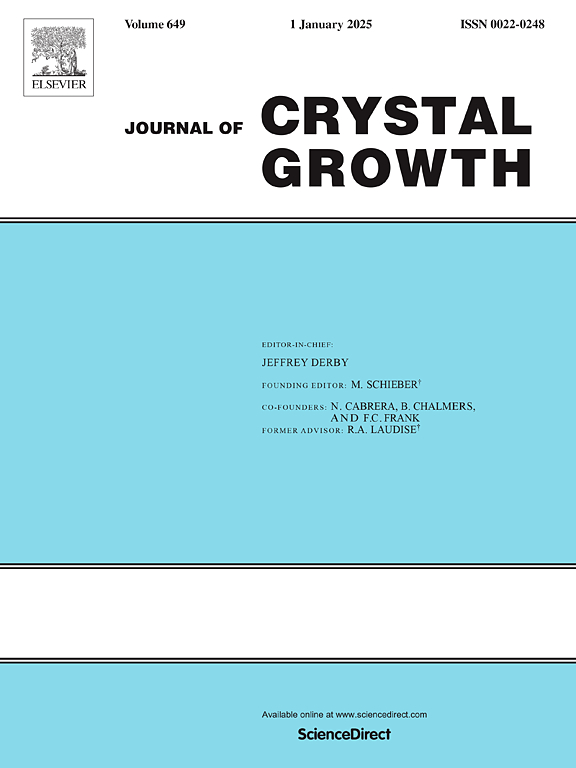基于分子束外延(MBE)衬底工程的二维GaSe外延薄膜应变调制
IF 2
4区 材料科学
Q3 CRYSTALLOGRAPHY
引用次数: 0
摘要
在这项工作中,我们系统地研究了GaSe薄膜在不同衬底上的外延生长,包括GaAs(100), GaAs(111), GaN/Al2O3(0001)和SrTiO3(001),使用分子束外延(MBE)。所有薄膜均呈现出基面上双轴拉伸应变与面外压缩应变耦合的通用应变结构,其大小随衬底类型而异。在立方GaAs衬底上,GaSe以排列良好的单畴生长,而六边形GaN和钙钛矿STO促进多畴取向,反映了界面对称性失配的作用。x射线衍射证实了面外晶格收缩,压缩应变范围从GaAs(1 00)的~ 1.3%到GaN(0001)的~ 2.5%。拉曼光谱显示平面内E2g2声子模式的红移,直接证明了双轴拉伸应变。这些发现表明,主要由对称失配控制的衬底诱导应变,为定制GaSe的光学和电子特性提供了一种强大而内在的途径,为应变工程二维光电器件提供了新的策略。本文章由计算机程序翻译,如有差异,请以英文原文为准。
Strain modulation in 2D GaSe epitaxial films by substrate engineering via molecular beam epitaxy (MBE)
In this work, we systematically investigate the epitaxial growth of GaSe thin films on different substrates, including GaAs(100), GaAs(111), GaN/Al2O3(0001), and SrTiO3(001), using molecular beam epitaxy (MBE). All films exhibit a universal strain configuration with biaxial tensile strain in the basal plane coupled with out-of-plane compressive strain, whose magnitude varies with substrate type. On cubic GaAs substrates, GaSe grows with well-aligned single domains, while hexagonal GaN and perovskite STO promote multiple domain orientations, reflecting the role of interfacial symmetry mismatch. X-ray diffraction confirms out-of-plane lattice contraction, with compressive strain ranging from ∼1.3 % on GaAs(1 0 0) to ∼2.5 % on GaN(0001). Raman spectroscopy shows red-shifts of the in-plane phonon mode, directly evidencing biaxial tensile strain. These findings demonstrate that substrate-induced strain, governed primarily by symmetry mismatch, provides a powerful and intrinsic route to tailor the optical and electronic properties of GaSe, enabling new strategies for strain-engineered 2D optoelectronic devices.
求助全文
通过发布文献求助,成功后即可免费获取论文全文。
去求助
来源期刊

Journal of Crystal Growth
化学-晶体学
CiteScore
3.60
自引率
11.10%
发文量
373
审稿时长
65 days
期刊介绍:
The journal offers a common reference and publication source for workers engaged in research on the experimental and theoretical aspects of crystal growth and its applications, e.g. in devices. Experimental and theoretical contributions are published in the following fields: theory of nucleation and growth, molecular kinetics and transport phenomena, crystallization in viscous media such as polymers and glasses; crystal growth of metals, minerals, semiconductors, superconductors, magnetics, inorganic, organic and biological substances in bulk or as thin films; molecular beam epitaxy, chemical vapor deposition, growth of III-V and II-VI and other semiconductors; characterization of single crystals by physical and chemical methods; apparatus, instrumentation and techniques for crystal growth, and purification methods; multilayer heterostructures and their characterisation with an emphasis on crystal growth and epitaxial aspects of electronic materials. A special feature of the journal is the periodic inclusion of proceedings of symposia and conferences on relevant aspects of crystal growth.
 求助内容:
求助内容: 应助结果提醒方式:
应助结果提醒方式:


